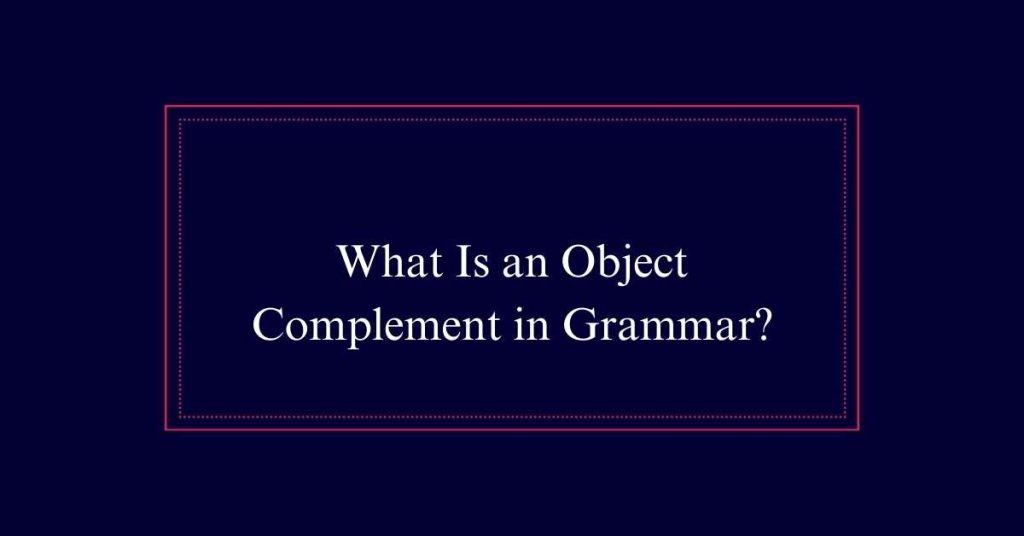What Is an Object Complement in Grammar?
An object complement is a word or group of words that provides additional information about a direct object, either by renaming or describing it, thereby completing the sentence’s meaning. It can be a noun, adjective, or phrase. For example, in ‘We made the room extra cozy,’ ‘extra cozy’ describes the room. In ‘The association named Max president,’ ‘president’ renames Max. Object complements are essential for adding clarity and detail to sentences.
Definition of Object Complement
An object complement is a word or group of words that provides additional information about the direct object in a sentence. It describes or renames the direct object, completing the sentence’s meaning.
Object complements are often nouns, adjectives, or noun/adjective phrases. For instance, in the sentence ‘We made the room extra cozy for our guests,’ ‘extra cozy’ is the object complement, providing more details about ‘the room.’
Similarly, in ‘The housing association named Max president for the coming year,’ ‘president’ renames the direct object ‘Max.’
Object complements are essential for clarity and precision in communication. They help convey how someone or something affects, thinks about, or talks about another entity, enriching the sentence’s meaning.

Role in Sentence Structure
Object complements play a pivotal role in sentence structure by providing additional information about the direct object. They complete the meaning of the sentence, often by renaming or describing the direct object.
This addition helps to clarify or specify the direct object, making the sentence more informative and precise. For instance, in the sentence ‘We elected Sarah team leader,’ the object complement ‘team leader’ tells us what Sarah was elected as. Without the object complement, the sentence would be incomplete and unclear.
Types of Object Complements
Within English grammar, object complements can be categorized into several distinct types, including nouns, adjectives, and noun/adjective phrases. Each type serves to provide more information about the direct object, enhancing the sentence’s overall meaning.
Here are the primary types:
- Nouns: These rename or identify the direct object, giving it a new title or identity.
- Adjectives: These describe the direct object, adding attributes or qualities.
- Noun Phrases: These provide a more detailed renaming of the direct object, often including modifiers.
- Adjective Phrases: These offer a more detailed description of the direct object, often including additional descriptive elements.
Examples in Sentences
To better understand object complements, let’s examine some examples in sentences. Object complements can rename or describe a direct object, adding essential information to complete the sentence meaning.
Consider the sentence, ‘We made the room extra cozy for our guests.’ Here, ‘extra cozy’ is the object complement describing ‘the room.’
Another example is, ‘The housing association named Max president for the coming year.’ In this sentence, ‘president’ renames the direct object ‘Max.’
Additionally, ‘Hearing this song always makes me happy’ shows ‘happy’ as the object complement describing ‘me.’
Finally, in ‘The teammates call their coach’s dog their unofficial mascot,’ ‘their unofficial mascot’ renames ‘their coach’s dog.’
Importance in Syntax
Understanding the importance of object complements in syntax is essential for mastering English sentence structure. Object complements complete the meaning of sentences, especially in the subject-verb-direct object-object complement pattern. They are vital for conveying specific details about the direct object.
Here’s why they matter:
- Clarity: Object complements provide clear information about the direct object.
- Precision: They allow for precise descriptions or renaming of the direct object.
- Complexity: They enable more complex sentence constructions.
- Expression: They enrich language by detailing how subjects affect or perceive direct objects.
Object Complements and Indirect Objects
Recognizing the difference between object complements and indirect objects is fundamental for mastering English sentence structure.
An object complement renames or describes the direct object. For example, in ‘We elected Sarah president,’ ‘president’ is the object complement, explaining Sarah’s new role.
Conversely, an indirect object indicates to whom or for whom the action is done. In ‘Sarah gave her friend a gift,’ ‘her friend’ is the indirect object receiving the gift. The distinct roles they play help clarify sentence meaning.
Object complements are part of the subject-verb-direct object-object complement pattern, while indirect objects fit into the subject-verb-indirect object-direct object pattern. Understanding these differences enhances sentence clarity and accuracy.
Object Complements Vs. Predicate Adverbs
Distinguishing between object complements and predicate adverbs is essential for mastering English sentence structure. Object complements describe or rename direct objects, while predicate adverbs modify verbs. To clarify:
- Object Complements: Often nouns or adjectives. Example: ‘We made the room cozy.’
- Predicate Adverbs: Modify the verb’s action. Example: ‘He sings beautifully.’
- Sentence Patterns: Object complements follow a subject + verb + direct object pattern. Predicate adverbs follow a subject + verb + adverbial phrase pattern.
- Function: Object complements provide essential meaning to the direct object. Predicate adverbs describe how or where the action occurs.
Common Mistakes
Misidentifying object complements and predicate adverbs is a common mistake that can lead to confusion in sentence structure. Object complements describe or rename the direct object, whereas predicate adverbs modify the verb.
For example, in ‘She painted the room blue,’ ‘blue’ is an object complement. It describes the room. In contrast, ‘She painted the room quickly,’ ‘quickly’ is a predicate adverb. It modifies the action of painting.
Another mistake is confusing object complements with indirect objects. Indirect objects receive the direct object, while object complements describe it. For example, ‘We named her the leader’ has ‘the leader’ as the object complement, not an indirect object.
Practice Exercises
To solidify your understanding of object complements, let’s work through a series of practice exercises. Identify the object complement in each of the following sentences:
- The committee elected Sarah team leader.
- Object Complement: team leader
- They painted the house bright yellow.
- Object Complement: bright yellow
- The jury found the defendant innocent.
- Object Complement: innocent
- We consider the project a success.
- Object Complement: a success







